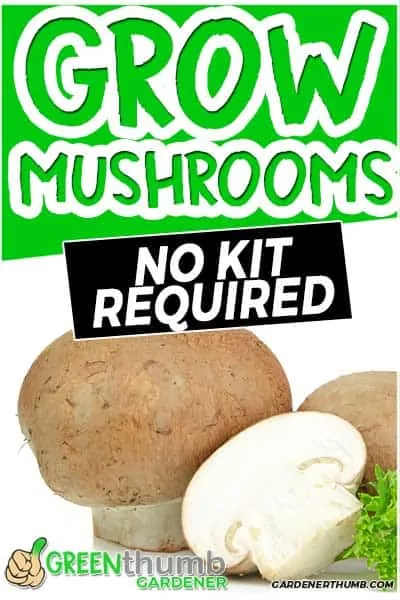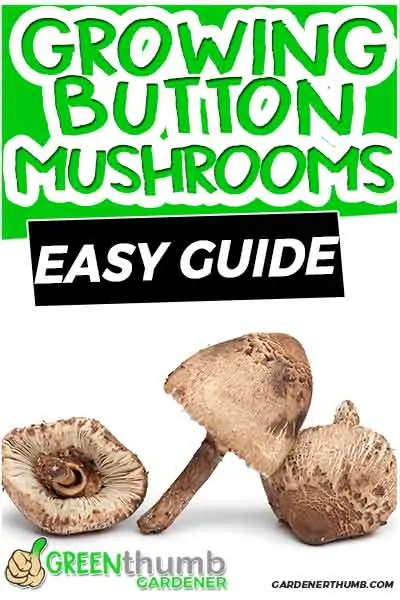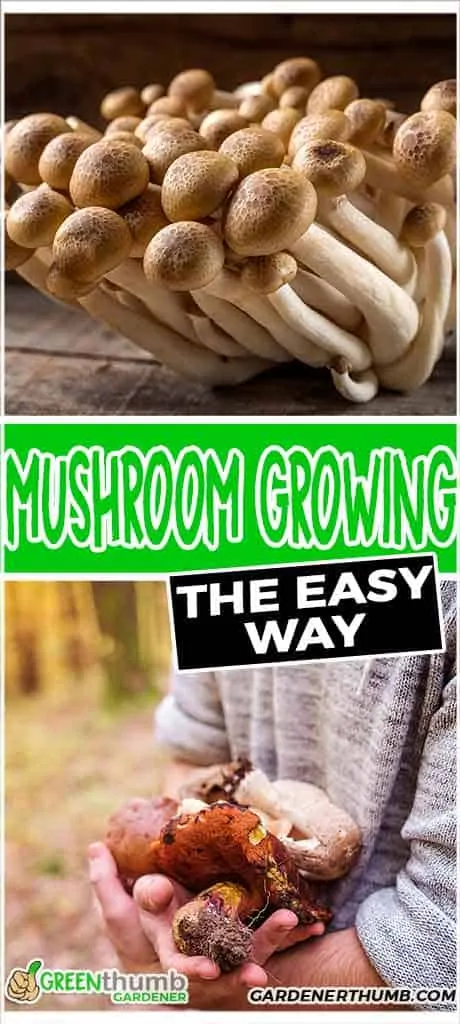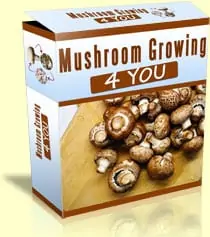How To Grow Button Mushrooms Without A Kit
Last updated: 9/15/20
If there’s one thing I’ve found quite challenging, it was how to grow mushrooms without a kit. However, it came with so many benefits that I couldn’t bring myself to stop.
I bet you’re also looking to enjoy these benefits when growing your mushrooms. Well, the great thing is that you don’t have to face the challenges I faced.
I’ve done considerable research and documented them. I’ve then put them together for you in this article.
Green thumb Gardener occasionally links to product and/or services offered by vendors to assist you with all your gardening needs. Some of these may be affiliate links, meaning we earn a small commission if items are purchased.
How To Grow Delicious Mushrooms At Home
Grow Your Own Organic Gourmet Mushrooms For Beginners
- Learn how to pick a strong mushroom strain for the best results
- Learn several of the best grow methods and choose the right one for you
- Setup your grow room the right way
- Over 7 hours of video instruction from an expert mycologist with over 15 years of experience
What Are Button Mushrooms?
You’ll hear loads of chatter about button mushrooms. And that’s why you’re interested in adding them to your gardening activities. Well, that was the reason I got interested in the first place.
So, just what are they?
Just like the name, they are a type of mushroom. However, they represent the most common type. You’ll even find them in most stores.
It’s a gilled fungus and naturally occurs in North America and Europe. It has a fair amount of minerals and vitamins. It provides excellent taste and can be cooked as food.
Varieties of Button Mushrooms
If you do decide to grow mushrooms, there are a variety of mushrooms you can grow. Typically, you can grow all types, with the exception being some unique mushroom variety.
The varieties you can grow includes:
- Cremini mushrooms
- White button mushroom
- Enoki mushrooms
- Portobello mushrooms
- Shiitake mushrooms
- Maitake mushrooms
- Oyster mushrooms
- Lion’s mane mushrooms
- Wine caps
However, it is essential to know that these varieties have some distinct needs.
For instance, you’ll need specific growing mediums to get the best results.
For instance, I found straw to be best suited for oyster mushrooms. I then got the best result when I tried shiitake mushrooms on hardwood sawdust and wood.

Then, decomposed manure worked best for white button mushrooms.
So, you might need to keep this in mind when choosing a variety.
Conditions Needed To Grow Button Mushrooms
Mushrooms are unique when it comes to growing conditions. And without a full understanding of these conditions, you’ll have a terrible experience.
A few months back, I tried out mushrooms for the first time. Since I wasn’t a beginner gardener anymore, I believed I could get to it. Well, I was wrong.
Button mushrooms come with its set of rules. And I say rules because if you fail to follow them, your mushroom will die.
Don’t worry; I’ll tell you about these rules. However, just before that, you also need to understand how mushrooms grow.
How Does A Mushroom Grow?
When it comes to mushrooms, they grow from a spore. Sounds familiar, right? Well, these are mushroom seeds. The only thing is that you can’t see them with your eyes.
These spores are usually best suited for substances like dust, grain, wood chips, and straw rather than your regular soil.
You’ll mix the spores with any of these substances to create spawn. Then, this spawn grows into a threadlike structure. In turn, this structure, regarded as mycelium, is what becomes your mushroom in time.
Conditions Necessary For A Button Mushroom To Grow
Now for you to grow a mushroom, here are the rules or conditions that are important.
Perfect Temperature
The first set of rules relates to the temperature of the area where you decide to grow.
Typically, mushrooms are best grown where the temperature is warm. As such, you will need to ensure that your compost is warm.
It’s simple, actually. The moment your compost gets chilly, your mushroom starts losing its life.
As such, keep it warm always. You can even use a heating pad in cases where it gets chilly. Heat up to 70 degrees Fahrenheit, and you’re good to go.
However, remember that while warm is good, too hot is bad. So, ensure you keep your spawn within the recommended temperature.
To Moisten Or Not
You cannot joke with the moisture level of your spawn if you want to record growth. You’ll need to keep it moist.
As such, it would be best to check it every day to ensure it’s moist. Where it isn’t, you can always spray a bit more water on it.
However, keep the spray gentle. Also, ensure that you don’t pour water directly into your spawn. This is because if you do, your spores won’t grow like you need them to.
Ideal Location
You’ll need to pay attention to your location if you intend to get the best results. Typically, this will involve getting a humid and dark location for your growing activities.
Typically, a spot below your basement or the sink will be a good location. Just keep in mind that you need somewhere dark where sunlight can’t penetrate.
Also, unless you’ve got three years to grow your mushrooms, avoid outdoor growing. You’ll waste loads of time on it.
Steps to Grow Mushrooms Without Any Mushroom Kit
Well, the truth is that I even believed that it was impossible to get my mushroom without a kit. Well, it turns out I was wrong.
The great reality is that you can grow mushrooms without a kit. Yes, it’s quite time-consuming. Yes, it’s somewhat stressful.
But, with this approach, you’ll have a smile on your face when the results are out.
So, let’s get to the step-by-step approach to growing mushrooms without a mushroom kit.
Step 1: Purchase Spawns
Like I already stated earlier, the spores and spawns are like your seeds. So, to get planting, you’ll need to purchase the spawn of your mushroom variety.
Although you can always purchase spores too, the process is lengthier. So, it would help if you went for spawns.
Step 2: Fill Your Medium or Container
Next is to find a medium for growth. Typically, a shallow container will get the job done. However, I’ve found pots or grow bags to be also useful.
Then, fill this container or grow bag with decomposed manure. And ensure the manures are fully decomposed.

Also, it would be best that you mix your compost with vermiculite. It complements the nutrients provided by the manure with moisture retention and aeration.
Afterward, sprinkle some spawn on your manure. At this point, don’t forget to provide water.
Step 3: Moisture Level
Like I already told you, your mushrooms need quite some moisture to grow. As such, provide a damp area for them.
It’s vital to ensure that your medium doesn’t dry out. You can always use a sprinkler and damp cloth to do this. Then, each time the cloth feels dry, you provide another sprinkler.
Green thumb Gardener occasionally links to product and/or services offered by vendors to assist you with all your gardening needs. Some of these may be affiliate links, meaning we earn a small commission if items are purchased.
Want to Download a Garden Hack Guide for FREE

Enter your email below and we will send you a guide to help you SAVE money in your garden.
Step 4: Heating Level
Again, your button mushroom needs quite a warm temperature. As such, you’ll need to keep this in mind throughout the growing stage.
However, the thing is that as mushrooms grow, their temperature needs changes. For instance, 70 degrees Fahrenheit works correctly at the beginning.
Then, when you get your threadlike mycelium, you’ll need to lower the room temperature to between 55 degrees and 60 degrees Fahrenheit.
While this might sound tricky, it’s not so hard. All you’ll need to get is a heating pad. Then, you can use it to optimize your mushroom’s temperature for the best effect.
Step 5: Harvest Your Mushrooms
After going through the growing process, you should be ready to reap. And this is usually between 3 and 4 weeks after sowing.
You’ll need your mushroom caps to be open. Then, you can effortlessly harvest them using a sterilized and sharp knife.
Ensure you avoid pulling the stem of your plant during harvest. This is because this practice can cause your young mushrooms to get destroyed.
Button Mushrooms Growing Tips
So far, you must have realized that growing mushrooms is quite different from other fruits and veggies. For instance, while you’ll need a constant supply of light for tomatoes, sunlight kills your mushrooms.
Well, so you can enjoy the best experience, here are some things to have in mind.
Casing
One thing that I’ve found quite useful is a casing. And this is useful once you start seeing the mycelium.
Usually, this occurs within three weeks. Once you see this, you can stop using the heating pad I mentioned earlier.
Then, mix vermiculite and manure in an equal percentage. Afterward, cover the mycelium with one inch of the mixture.
This will ensure that your button mushrooms can bloom and appear.
It’s also not a bad idea to mix soil and peat or chalk and peat. However, ensure you cover the mixture with your plastic after this.
Still, it would be best to get some sprinkle of water before you cover. Again, a sprinkle. So don’t pour water on your mycelium.
Continuous Supply
After my first harvest, I found myself back at the store buying spawns. I have harvested all my mushrooms and had nothing growing on it again.
Well, you can avoid this easily.
All you’ll have to do is ensure your mushroom has a high moisture level with the damp cloth on. Then, you can guarantee yourself a steady supply for a minimum of six months.
Common Pest and Diseases
If you want to enjoy any reward from your growing expedition, then this is essential. You’ll need to fight off pests and diseases.
I’ve had my fair share of troubles with them. And I can tell you they are extremely disturbing.
So, here are some of my top picks that you should look out for. And, of course, how to get rid of them.

Further Reading
Dactylium Disease
This disease is one that you’ll usually come across. It appears like a cottony, webbed growth on your mushroom and casing surface.
In some cases, it will turn pink or gray. Then, it would cause your mushroom to develop a watery and soft rot.
Luckily, you can quickly get rid of this disease through proper sanitation practices. All you’ll need to do is keep your tool, equipment, and casing sanitized and clean.
Verticillium Spot
This is also common and takes the form of deformed mushrooms or small spotting on your mushroom.
It can even become severe and results in a dry bubble. Your mushroom might also get covered with fuzzy, gray growth.
Well, it’s not irredeemable. You can easily apply salt to get rid of this.
All you’ll need to do is put some salt inside a cup. Then, place it near the fuzzy bubbles. They should dry in time.
You might want to avoid fungicides. This is because they have the likelihood to kill your mushrooms too.
Green Mold
You’ve got green mold as soon as your mycelium’s dense layer begins to change to green. You can be super sure as soon as your mushroom becomes distorted, cracked, or green.
You can always avoid and remedy this through proper sanitation practices. Also, ensure that you adequately sterilize your compost before use.
Green thumb Gardener occasionally links to product and/or services offered by vendors to assist you with all your gardening needs. Some of these may be affiliate links, meaning we earn a small commission if items are purchased.
How To Grow Delicious Mushrooms At Home
Grow Your Own Organic Gourmet Mushrooms For Beginners
- Learn how to pick a strong mushroom strain for the best results
- Learn several of the best grow methods and choose the right one for you
- Setup your grow room the right way
- Over 7 hours of video instruction from an expert mycologist with over 15 years of experience
Final Thoughts
You can always go on and purchase a mushroom kit for around $50. However, it can be quite expensive.
Well, you don’t have to lose money anymore. You can easily grow your mushroom yourself. And without a mushroom.
I’ve been there and done it. Now it’s your turn. All you need to do is follow all the points above, and you’ll be good to go.
Related Questions
1. Can I Grow Mushrooms from Store-Bought Mushrooms?
Yes, you can, and the growing process is even faster. You don’t have to wait for spores; you easily maximize the mycelium on your mushroom.
2. Can You Grow Button Mushrooms at Home?
You can grow mushrooms at home. All you’ll need to do is mix manure and compost equally, then pour it on a tray where you can add spores and wait for your mushrooms to sprout.
3. How Do You Grow Mushrooms Naturally?
All you need to do is:
- Place sawdust into a pan and dampen it with water
- Add your spores to it and cover it with sawdust;
- Cover it using a plastic bag, or you can put it into a plastic container
- Keep misting your tray each day until it retains its moisture level
4. How Hard Is It to Grow Mushrooms at Home?
It can be quite challenging to grow your mushroom at home due to the strict climatic conditions it requires. Still, with enough effort, you can recreate the conditions and have it growing in no time.










